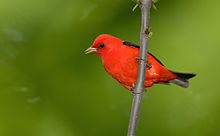Scarlet tanager
| Scarlet tanager | |
|---|---|
 |
|
| Adult male | |
| Scientific classification | |
| Kingdom: | Animalia |
| Phylum: | Chordata |
| Class: | Aves |
| Order: | Passeriformes |
| Family: | Cardinalidae |
| Genus: | Piranga |
| Species: | P. olivacea |
| Binomial name | |
|
Piranga olivacea (Gmelin, 1789) |
|
| Synonyms | |
|
Piranga erythromelas |
|
Piranga erythromelas
The scarlet tanager (Piranga olivacea) is a medium-sized American songbird. Until recently placed in the tanager family (Thraupidae), it and other members of its genus are now classified as belonging the cardinal family (Cardinalidae). The species' plumage and vocalizations are similar to other members of the cardinal family, although the Piranga species lacks the thick conical bill (well suited to seed and insect eating) that many cardinals possess.
The genus name Piranga is from Tupi Tijepiranga, the name for an unknown small bird, and the specific olivacea is from New Latin olivaceus, "olive-green".
The scarlet tanager, a mid-sized passerine, is marginally the smallest of the four species of Piranga that breed north of the Mexican border. It can weigh from 23.5 to 38 g (0.83 to 1.34 oz), with an average of 25 g (0.88 oz) during breeding and an average of 35 g (1.2 oz) at the beginning of migration. Scarlet tanagers can range in length from 16 to 19 cm (6.3 to 7.5 in) in length and from 25 to 30 cm (9.8 to 11.8 in) in wingspan. Adults of both sexes have pale horn-colored, fairly stout and smooth-textured bills. Adult males are crimson-red with black wings and tail. The male's coloration is intense and deeply red, similar but deeper in shade than the males of two occasionally co-existing relatives, the northern cardinal and the summer tanager, both which lack black wings. Females are yellowish on the underparts and olive on top, with yellow-olive-toned wings and tail. The adult male's winter plumage is similar to the female's, but the wings and tail remain darker. Young males briefly show a more complex variegated plumage intermediate between adult males and females.
The somewhat confusing specific epithet olivacea ("the olive-colored one") was based on a female or immature specimen rather than erythromelas ("the red-and-black one"), which authors attempted to ascribe to the species throughout the 19th century (older scientific names always takes precedence, however).
...
Wikipedia

